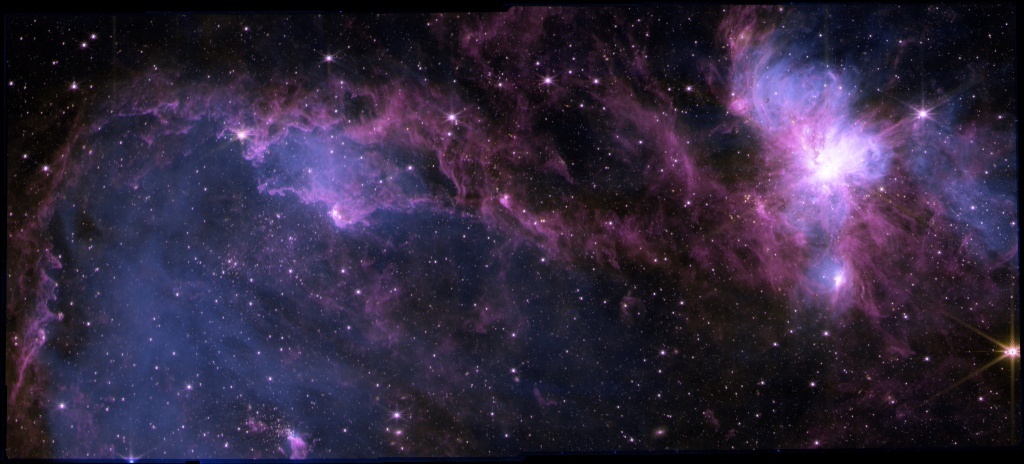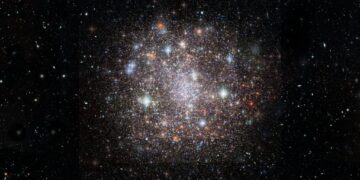Astronomy has once again offered us a window into the past with the discovery of a newly forming super star cluster (SSC) in the Large Magellanic Cloud (LMC). Located just 160,000 light-years away, this young SSC, designated H72.97-69.39 (H72), is a rare opportunity for astronomers to study conditions that mirror the universe’s early star-forming eras.
What Are Super Star Clusters?
Super star clusters are the stellar factories of the universe. These densely packed regions are home to hundreds of thousands of stars forming simultaneously. Six or seven billion years ago, SSCs were the main sites of star formation, driving the creation of galaxies as we know them today. While SSC formation has slowed significantly in modern times, the discovery of H72 in the LMC provides a rare glimpse into how these clusters form.

Located within the massive star-forming N79 nebula, H72 is only 100,000 years old—a cosmic infant compared to other known SSCs.
The Role of the Large Magellanic Cloud
The Large Magellanic Cloud, a satellite galaxy of the Milky Way, is an ideal laboratory for studying star formation. Its proximity and orientation make it easier for astronomers to observe its star-forming regions. The LMC’s metallicity—about half that of our solar system—mimics conditions in the early universe, making it a perfect setting to study primordial star formation.
The N79 region, where H72 resides, spans roughly 1,630 light-years and is filled with interstellar gas, dust, and young stars. Observations with JWST’s Mid-Infrared Instrument (MIRI) and ALMA have revealed the intricate processes fueling the formation of this SSC.
The Discovery of H72.97-69.39
H72 is a unique find, not just because of its age but also due to the advanced techniques used to uncover it. The JWST identified 97 young stellar objects (YSOs) in the N79 region, many of which are part of this forming cluster. What was once thought to be single massive stars are now known to be clusters of protostars.
This discovery highlights the hierarchical nature of star formation, where massive stars dominate the luminosity of their regions, but their origins are tied to smaller clusters of forming stars. Such insights challenge existing theories about the birth of massive stars and SSCs.
How Super Star Clusters Form
H72’s formation is fueled by molecular gas filaments, as revealed by ALMA observations. These filaments, stretching over one parsec, collide and channel material into the cluster, providing the necessary mass for rapid star formation. This process aligns with theories that SSCs form in regions of high gas density, where gravitational forces compress material into tightly bound clusters.
The segregation of YSOs by mass within H72 is another intriguing aspect. Massive YSOs are concentrated at the cluster’s center, while smaller ones are found in its outskirts. This mass distribution offers clues about the dynamics within forming clusters and the role of gravity in shaping their structure.
Why This Discovery Is So Important
Studying H72 allows astronomers to rewind the clock and observe star formation as it likely occurred billions of years ago. The LMC’s lower metallicity provides conditions similar to those of the early universe, making this discovery a proxy for understanding the universe’s most active star-forming periods.
Moreover, SSCs like H72 play a crucial role in shaping galaxies. Their massive stars emit intense radiation and winds that influence the surrounding interstellar medium, triggering further star formation or dispersing gas and dust.
The Power of Modern Astronomy
The discovery of H72 underscores the capabilities of modern observatories. JWST’s infrared imaging can penetrate dense clouds of gas and dust, revealing the hidden stars within. Its detailed observations allowed researchers to measure the chemical composition of the N79 region, identifying organic molecules, dust, and ice that fuel star formation.
ALMA’s ability to observe molecular gas in fine detail complements JWST’s findings. By mapping the movement and distribution of gas filaments, ALMA provides critical insights into the mechanisms driving H72’s formation. Together, these instruments offer an unprecedented view of a super star cluster being born.
Implications for Star Formation Theories
The findings in H72 challenge and refine existing theories about massive star cluster formation. The role of colliding molecular filaments as a catalyst for SSC formation is a significant insight, suggesting that such interactions may have been common in the early universe.
Additionally, the hierarchical structure of H72, with clusters of protostars forming massive YSOs, offers a new perspective on how massive stars emerge. This discovery also highlights the importance of studying low-metallicity environments, which can reveal processes hidden in more chemically enriched regions like our Milky Way.
Future Research Directions
H72 is just the beginning of what astronomers hope to uncover in the LMC and beyond. Future studies will focus on:
- Chemical Analysis: Further examining the gas and dust composition in N79 to understand the building blocks of stars.
- Mass Accretion Rates: Investigating how quickly stars in H72 gain mass, shedding light on their growth processes.
- Other Star-Forming Regions: Expanding observations to similar regions in the LMC and other nearby galaxies.
The combination of JWST and ALMA will continue to be instrumental in these efforts, providing the high-resolution data needed to answer these questions.
Lessons from H72
H72 teaches us that the universe is still a dynamic and evolving place. Even though the peak era of SSC formation has long passed, studying young clusters like H72 helps us understand the processes that shaped galaxies during their formative years.
This discovery also reminds us of the interconnectedness of cosmic phenomena. The molecular gas filaments fueling H72’s formation are part of a larger cycle of star birth and death, where elements forged in stars are returned to the interstellar medium, seeding future generations of stars.
Conclusion
The discovery of H72.97-69.39 in the Large Magellanic Cloud is a monumental achievement in astrophysics. It not only provides a rare opportunity to study a newly forming super star cluster but also deepens our understanding of the universe’s early star-forming epochs. By combining the unparalleled capabilities of JWST and ALMA, astronomers have unlocked new insights into the processes that drive star formation, shaping galaxies and enriching our knowledge of the cosmos.
Referemce:

















